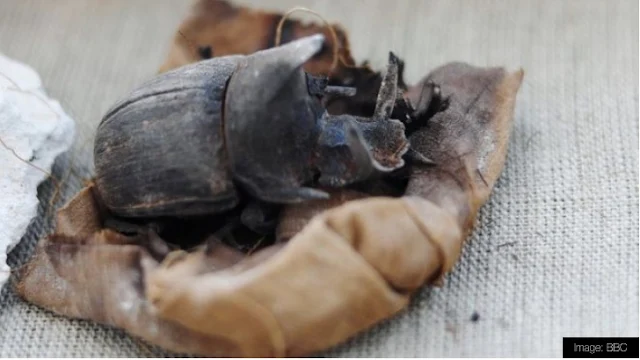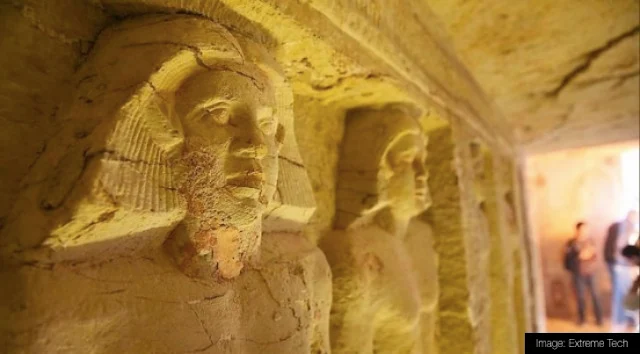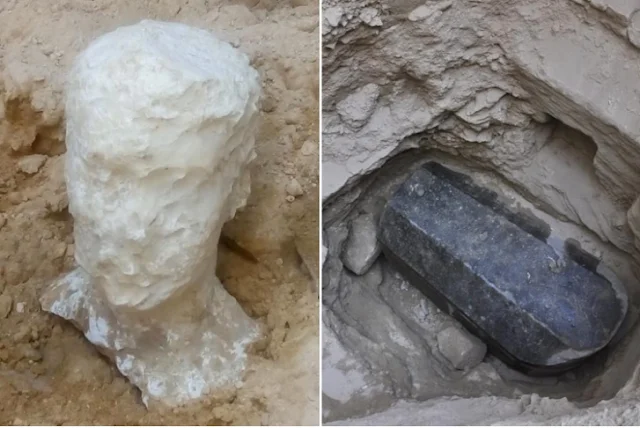Archaeologists were ecstatic to discover historic artifacts buried beneath
the sand when the Egyptian government dispatched them to excavate a
previously undiscovered region of the desert. The unprecedented find has the
potential to alter all we know about ancient Egypt and will no doubt leave
academics perplexed. Boy, did they strike gold.
In the Deserts, Hidden
Archaeologists and Egyptologists have been searching for and finding
thousands of ancient artifacts and mysteries hidden in Egypt's deserts since
the early 1800s. We haven't yet discovered many buried treasures,
though.
They Had Good Luck
Researchers occasionally stumble upon priceless historical treasures just
beneath the surface, but they aren't always that fortunate. The task of the
archaeologist is a delicate scavenger hunt because of the attention to
detail and cunning of the ancient people who erected these tombs.
Restoring Damage
In recent years, Egypt's Ministry of Antiquities has made an effort to
oversee new expeditions around the nation, purportedly in order to find new
discoveries but also in order to aid in repairing the harm that has been
done over time by tomb raiders and thieves.
Unexpected Meeting
Many locations, including the Great Pyramids, have remained entirely
unsecured since the Egyptian revolution in 2011. Grave robbers take
advantage of this by plundering the region and stealing items, some of which
are connected to the criminal underground and others of which are just
taken.
thieves of tomb
Children were employed to enter the tomb shafts since they were too narrow
for adults to fit through, which led to harm and occasionally fatalities. As
if the death toll wasn't horrible enough, the thieves also irreparably
destroyed several tombs.
Huge Findings
The necropolis of Saqqara, a historic site from long ago, was one of the
recently unearthed locations. In 2018, the Ministry of Antiquities made
ground-breaking discoveries of unique, well-preserved antiquities. The "most
magnificent tomb unearthed this year," according to one find, is the Coffin
of Saqqara.
What distinguishes this website from others? Many significant ancient
artifacts were lost or stolen, but a gold-plated silver mask was found
concealed within a coffin made of wood. Excavators were ready for the other
riches hidden in Saqqara's depths as there aren't many treasures of this
sort.
An Old Mask Was Discovered
The mask's discovery thrilled the archaeologists. Since it was the first
quest in the region since 1900, it was likely an indication that other
important objects were nearby.
The Hint
Soon after the mummy was found, investigators found further antiquity
items. Seven graves were concealed behind a stone ridge, one of which
contained rare scarab beetles and mummified cats.
Moribund Animals
Animals were fossilized as part of religious gifts, while human remains
were mummified to preserve them for the afterlife. The scientists were
thrilled to discover the gateway to an undisturbed tomb thought to hold
human remains after gathering the well preserved critters.
4,400 Years in Slumber
The elaborately sculpted grave of a high priest named Wahtye was concealed
and unaltered for 4,400 years. He was given a high-ranking position in the
priesthood during the Fifth Dynasty by King Neferirkare Kakai.
The sculptures
The 33-foot-long, 9-foot-wide, and 10-foot-tall tomb included a wealth of
information on the guy interred within its walls. Wahyte's life was
portrayed in intricate sculptures, paintings, and hieroglyphics. The high
priest was actually somewhat of a "mummy's boy"
His Adoration of His Mother
Archaeologists struggled to locate a place in the tomb where Wahyte wasn't
paying tribute to his adored mother, Merit Meen, who was also interred there
with him. The walls were covered with monuments, paintings, and drawings by
his mother.
Commerce
Wahyte's wife, Weret Ptah, is mentioned in inscriptions but was not given
much attention. After been painted on the limestone walls for millennia, the
intricate images could now be seen by new visitors.
Site of Saqqara
There was a wealth of knowledge about daily life in ancient Egypt at the
Saqqara site. With depictions of musical performances, pottery, winemaking,
seafaring, and furniture manufacturing, ancient Egypt seems to be a
contemporary youthful, educated city dweller's modern civilization.
The Final Tomb
They discovered more about Wahtye when they explored the tomb's inside. The
crew found out intriguing information about Wahtye's life, family, and
status in the fifth dynasty, but they were also searching for the ultimate
prize: Wahtye's secret final resting place.
They Had Good Luck
On December 13, 2018, the excavating crew had a stroke of good fortune.
Five shafts were made visible when the last piece of surface debris was
removed. So they began the difficult and drawn-out process of getting
inside...
What lies within the tomb?
They were shocked to see the first shaft open. Which made sense considering
that when they opened it, it was absolutely empty. On the other side, the
four more shafts may contain insights that contemporary society had not yet
experienced.
Having a last look inside
The Supreme Council of Antiquities' general, Mostafa Waziri, remarked, "I
can assume that all of the artefacts might be located in this location." He
said that the remaining shafts held the largest solutions. "This tunnel
ought to go to the owner of the tomb's sarcophagus or coffin."
Showing Off More Chambers
As the excavation moved further in the upcoming months, officials expected
to find more in the intact rooms. The archaeologists manually excavated,
sifting through sand and pebbles in search of further prehistoric
items.
What Else Was Discovered?
In Alexandria, Egypt, not far from Wahtye's, construction workers struck
something that went beyond bedrock during a regular dig. They understood
that this was a significant moment.
A Hot Spot, that
Artifacts found in King Tut's tomb's pyramids in Egypt can be magnificent
finds. Particularly the old city of Alexandria was a bustle of
activity.
Where To Trade
The city was a lively harbor full with ships, traders, and merchants during
its heyday in antiquity. Alexander the Great established the city, which
functioned as a bridge between Greece and the Nile Valley of Egypt.
The Change Was Significant
Clearly, Alexandria is not what it was in the past. It is today a heavily
inhabited city with a vast number of establishments and homes.
It Was rather large.
The huge tomb was unearthed 16 feet below the surface by construction
workers as they were preparing the foundation for a new structure. According
to archaeologists, the tomb was constructed between 305 and 30 B.C. during
the Ptolemaic era.
They were shocked.
A large, calm-looking black coffin was located in the tomb's corner. When
compared to other ones discovered around Egypt, this one was particularly
huge, which had experts wondering what may be within.
An Alabaster Head was present.
A gigantic head made of alabaster was placed next to the enormous black
tomb. The head's characteristics had gotten worse over time, but no one
could determine if it was supposed to be a model for a significant person,
so they decided to look into it.
They attempted to pry it.
A group of about a dozen men attempted to remove the tomb lid, but it was
quite heavy! They would need to bring in some large equipment. The team also
got in touch with a subject-matter authority...
They Accompanied The Expert
He worked for Egypt's Ministry of Antiquities for many years and went by
the name of Ayman Ashmawy. He was used to examining historical items. The
only person who could explain what was happening was him!
Strange Items
Indicating that the lid and body had been properly sealed for more than
2,000 years, he observed a layer of mortar between them. In addition, black
granite, a scarce stone at the time, was used in its construction. This
prompted a significant query...
Something That'll Draw Burglars
Was the person buried inside a high-ranking official or a famous person?
The tomb was quickly surrounded by a fence. Now that word of the find was
getting out, it was probably going to become a target for would-be thieves
and vandals.
The Malice
The objective was to finally take the lid off, but some people had their
doubts. According to several traditions, the Pharaoh's curse was released
when particular tombs were uncovered. Was there an ominous sign there?
The Countless Options
Because of its size and distinctive black granite construction, most people
imagined someone very significant was interred there. Is there a chance that
Alexander the Great was directly involved? Eventually, they'd find it
out...
Opening The Tomb Safely
The workmen secured the lid with the use of large cranes and heavy rope. If
it dropped in the midst of a lift, it might not only destroy everything was
within but also seriously hurt anyone who were nearby. They gently opened
the casket using the crane's force.
Yucky Smell welcomed them
The employees hastened to leave the unpleasant smells that were quickly
evaporating from the now-open tomb. After a few minutes, the most of the
fragrance had vanished, leaving the employees to stare at the inside
remnants.
Waste and skeletons
Three malformed skeletons were submerged in a viscous crimson liquid. The
crimson liquid was found to be hazardous waste that had poured into the tomb
and had over time matured into an unpleasant-smelling slime. The bones were
recognized as being soldiers.
Making A Drink Out Of It
The crimson ooze was turned into a palatable, fizzy energy drink by Innes
McKendrick. He thought that if people drank the liquid, they would acquire
"powers." Fortunately, despite signatures, the corpse juice won't be
ingested.
Long Five Years
There are no indicators that the Egyptian discoveries will stop.
Researchers found a 2,000-year-old network of tombs beneath the city of
Cairo! Nevertheless, it may take up to five years to fully excavate this
enormous discovery.
The Soldiers' Tomb
Egypt is still being uncovered, and quickly. According to archaeologists, a
network of tombs dating back 2,000 years has been found under Cairo! The
excavation of this enormous discovery, however, might take up to five
years!
California Desert Excavation
Egypt is still being uncovered, and quickly. According to archaeologists, a
network of tombs dating back 2,000 years has been found under Cairo! The
excavation of this enormous discovery, however, might take up to five
years!
There Was Strangeness
A curving nose, delicate ears, and the ridges of a majestic crown welcomed
the explorers as they wiped aside sand and debris. The characteristics
originated from something a little more exotic: the head of a sphinx, not
from a centuries-old American monument.
The California Sphinx is it.
Naturally, there were a ton of questions for the archaeologists, the most
important of which was: How? What did Santa Barbara have to do with an
Egyptian sphinx head? Fortunately, it didn't take the archaeologists long to
see that something wasn't quite right with the sphinx head.
Maybe it's a fake one.
For the purpose of creating an actual sphinx head from ancient Egypt,
bedrock was employed. Although large, the one found in California was
constructed of a much lighter substance that left powder on the researchers'
hands.
What Source Did It Have?
At this time, they concluded the sphinx head was not native to Egypt's
deserts. It had not been smuggled or transported to Santa Barbara by thieves
or aliens. The 300-pound head, on the other hand, appeared out of
nowhere.
It's A Set Up
Initially, it was believed that the sphinx head came from Charlton Heston's
performance in Cecil B. DeMille's 1956 movie The Ten Commandments. The head,
however, had to come from an even earlier movie, which it did because of the
breakthrough visual effects in the movie.
Regarding Special Effects
The Ten Commandments was not DeMille's first adaptation; it came in 1956.
He made an attempt to turn the biblical tale into one of the earliest "epic"
movies in 1923. In contrast to the 1956 film version, he won't be able to
rely on computer-generated effects.
Nipomo-Guadalupe Dunes
DeMille's 1923 adaption was filmed at the Guadalupe-Nipomo Dunes in Santa
Barbara because he believed they resembled the Egyptian desert. Moses' whole
universe was constructed by hand by the set designers, and it was
enormous.
Huge props were utilized.
Over 1,600 individuals are said to have worked on the construction of 21
sphinxes, eight lions, an Egyptian temple, four 35-foot Pharaoh sculptures,
and 110-foot gates.
It Was An Odd Sphinx.
At the time, the set was one of the biggest and most costly ever
constructed. With 25,000 nails and 250 tons of plaster, it was built to be
12 storeys high and 800 feet wide. The decoration on the sphinx heads was
the most peculiar feature of them.
100 years later
Because a large portion of the movie was shot in black and white, it was
essential to employ Technicolor to make the sphinxes shine out when the
lighting and shadows were applied. When they were discovered nearly a
century after they had been caught on film, they seemed to be a little
different in person than they looked on film.
Filming of Significant Scenes With Technicolor
The "very strong" colors used to paint the sphinx heads astounded
archaeologists. With the exception of one of the most important moments,
which was captured in B&W, the remainder of the film was shot in
Technicolor.
Jell-O usage
Both versions require the Red Sea to be divided, but the '23 movie had to
come up with novel ways to do this. The "parted sea" look was photographed
as it was created when generating waves in a Jell-O slab.
Then what?
Cecil B. DeMille was pleasantly delighted that the filming could be
finished in three months despite implementing his audacious ideas. He was
now confronted with the decision of what to do with the set.
One of the earliest "iconic" movies produced in Hollywood, Reality DeMille
used to have a love/hate relationship with his own picture. He had largely
directed the expansion of a metropolis that would have been impossibly
expensive to leave and immeasurably valuable to do so. And to make matters
worse, he was fully aware of the reality of the situation.
A choice was made.
Hollywood producers reused sets and props to cut costs on the filming
process. DeMille, ever the artist, was not going to let another director
truly profit from his labor, though. Consequently, he made a foolish
choice.
Prophet: DeMille DeMille wrote in his book, "I hope they will not hurry
into print with the astonishing news that Egyptian civilization...extended
all the way to the Pacific Coast," if archaeologists happen to dig beneath
the dunes of Guadalupe in a thousand years.
The Set Was Buried
DeMille believed that nobody else would utilize his lavish set if he
couldn't. He insisted that the entire building be torn down and that
everything that might be repaired be buried beneath.
Maintaining High Standards
For Cecil B. DeMille, there was no such thing as excessive, according to
author Scott Eyman. DeMille's ability to reprimand anyone—from extras to the
lead actor—who fell short of his expectations was praised, as was his
strong, authoritative directing style.
The History of Hollywood
DeMille's meticulous techniques caused his artificial metropolis to be
buried. Over the years, archaeologists have discovered comparably little
fragments of "artifacts" from The Ten Commandments movie, but the largest
discovery was the almost-complete sphinx head they discovered in the
sand.
It Will Take Work To Save It.
According to Doug Jenzen of the Guadalupe-Nipomo Dunes Center, "Given that
these artifacts have endured for 94 years, even though they were only
designed to survive for two months during filming, it truly testifies to the
craftsmanship." Nevertheless, it will be quite challenging to retrieve these
relics.
Maintaining The Prop
When it was reached, the first sphinx head disintegrated into powder since
it was constructed of plaster of paris. When they recovered the skull from
the sand the second time, the archaeologists had to use a foam spray to
fortify the interior of the head so they could remove it without harming
it.
Treasures Buried Deep in the Earth
The skull may not even have originated in the vast Egyptian deserts, but it
is still a piece of Hollywood history. The movie sets from that era of
Hollywood's development are just nonexistent now, according to Jenzen. Now
they do...along with a fragment of one, hidden beneath the sand dunes.
A golden age
Hollywood's business strategy has always relied on violating the law to
make money. Thomas Edison, who resided on the East Coast and held the
patents for nearly all of the filmmaking equipment available at the time,
was paid royalties, thus early film companies established themselves in Los
Angeles to avoid doing so.
Increase In Studios
In a similar vein, studios struggled to establish themselves throughout the
silent cinema period, but eight companies emerged as the leaders after the
1920s. The majority of the town was under the management of MGM, Warner
Bros., 20th Century Fox, RKO, and Paramount, with United Artists, Universal,
and Columbia sharing their area.
What Has Been Done
The European wars brought in a lot of money for Hollywood. In the quest for
amusement during World War I, the American cinemascape advanced because
other countries were distracted with war. Americans splurged at the movies
because they yearned for levity and distraction.
They Want Charm
Studios demand a big number of stars in order to satisfy client
expectations. Searching for fresh talent, shark-like talent scouts explored
the neighborhood's theaters, eateries, and even the streets. Most famous
people were targeted for their sex appeal, such Lana Turner, who was called
"Sweater Girl" due to her form-fitting clothes.
The Care of the Celebrities
The studios would take care of the rest if new concepts passed the screen
test and looked fantastic on film. Actors were under intense pressure to
attend charm schools, adhere to rigid fitness and health regimes, and even
undergo cosmetic surgery.
Being Classified
Back then, a performer could get away with taking on a range of characters.
All actors were typecast and cast as protagonists, side roles, or extras.
Once the studio identified an iconic character type for you, that role
became your primary focus indefinitely. You were given the roles that your
contract required.
Zero privacy
Additionally, after the day was through, celebrities had not completed
their task. Studios paid close attention to their personal lives in order to
maintain their marketability. Nobody was permitted to be gay, and issues
like substance misuse and pregnancy were forbidden.
Consequences
Celebrities' contractual studios may be compelled to lend them out to other
production firms as a form of discipline if they are discovered to be
infringing the regulations too frequently. Until you realize that actors
weren't paid for movies they filmed outside of their home studio, it doesn't
seem like a horrible concept.
Banned Films
Then the infamous "Hays Code" fable emerged, adding to an already deceptive
business. Studios put in place their own self-censorship system after the
government threatened to pull movies containing content it found
unacceptable.
The Laws This rule, named after MPPDA President Will H. Hays, forbade
on-screen sexism, feminism, nudity, multiracial partnerships, non-hetero
characters, and even pregnancy. By the movie's conclusion, bad guys had to
pay a price, and characters who were husband and wife had to share a
bed.
It's not real.
Additionally, the "happy ending" has evolved into the accepted manner to
wrap up a movie. The European customs of the silent cinema period, in which
people dressed and behaved whatever they chose, confronted genuine risks,
and contemplated life's gloomy realities, were long gone.
Pregnancy
American movie characters were not allowed to be pregnant, and the
performers who played those characters were also not allowed to be pregnant.
Beyond the Hays Code problem, studios pushed pregnant women to abort their
pregnancies because they thought it would make the star less
marketable.
Tags:
history




































